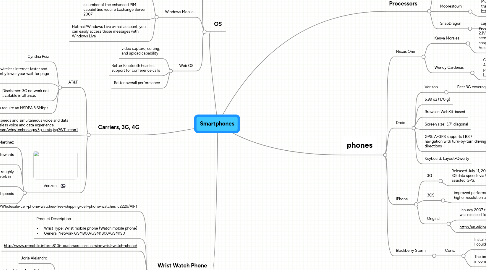
1. Wrist Watch Phone
1.1. http://www.hotsaleoutlet.com/Wholesale-cell-phone-watches-free-shipping-cell-phone-watches_c2229/All-1
1.2. Product Description • Wrist Type: Wrist mobile phone (Watch mobile phone) • General Network GSM900/GSM1800/GSM190
1.3. http://www.c-mobile.info/m810i-touch-screen-dual-sim-wrist-watch-phone/
1.4. wrist watch phone
1.4.1. pros:
1.4.1.1. Jorje Alejandro
1.4.1.2. A watch phone replaces two devices: a wrist watch and a cellphone.
1.4.1.3. You get it all, a cell phone, mp3 player, video player, digital and video camera.
1.4.1.4. Ted DiPerna
1.4.2. cons:
1.4.2.1. A watch phone’s size is much bigger than a normal wrist watch.
1.5. http://www.thewatchphones.com/articles/
2. OS
2.1. Linux
2.1.1. Linux OS supports more processors than any other operating system on the market
2.1.1.1. http://communication.howstuffworks.com/smartphone2.htm
2.2. Windows Mobile
2.2.1. he interface largely remains the same to regular OS
2.2.2. a number of the enhanced PIM capabilities require Exchange Server 2007
2.2.3. Hotmail/Windows Live e-mail account, you can easily access those messages with Windows Live
2.3. Web OS
2.3.1. video capture, editing, and upload capability
2.3.2. Better Bluetooth headset support for conference calls
2.3.3. Better overall performance
3. Carriers, 3G, 4G
3.1. AT&T
3.1.1. Cynthia Peiz
3.1.2. Surf the wireless Internet faster and significantly lower your wait for page loads
3.1.3. Disclaimer: 3G network not available in all areas
3.1.4. Disclaimer: Referenced speeds require an HSDPA 3.6Mbps.
3.2. 3G provides accelerated data speeds and simultaneous voice and data capabilities for an amazing wireless voice and data experience. http://www.wireless.att.com/learn/why/technology/3g-umts.jsp?WT.srch=1
3.3. Verizon
3.3.1. Janett Martinez
3.3.2. Verizon Wireless is also making headway towards getting its 4G network in place.
3.3.3. their 4G LTE network will be roughly similar to its current 3G network in terms of size.
3.3.4. their network has seen peek download speeds of around 50Mbps.
3.3.4.1. http://www.techreviewsource.com/content/view/411/1/
4. Processors
4.1. ARMS
4.1.1. Nearly every smartphone on the market contains an application processor based on processor cores from ARM.
4.1.1.1. http://www.pcmag.com/article2/0,2817,2360152,00.asp
4.2. Moorestown
4.2.1. Moorestown is the Intel Corporation's Atom processor based system-on-a-chip that's designed for smartphones. Steven A. http://www.linuxfordevices.com/c/a/News/OpenPeak-OpenTablet-7/
4.3. SnapDragon
4.3.1. capable of 1080p HD video Playback
5. phones
5.1. Nexus One
5.1.1. Kenya Morales
5.1.1.1. Pros: 1.)The Nexus One only weighs 130 grams. 2.)Video can be played for well over 3 hours 3.) The screen will self adjust brightness 4.)5 megapixel snapper with flash. 5.You can assign your Google Voice number
5.1.2. Wendy Cardenas
5.1.2.1. Cons: 1. choice of coloring 2. no physical camera key 3. color balance. 4. tinny loudspeaker. 5. the dated and always-underwhelming music player has undergone almost zero change http://www.engadget.com/2010/01/04/nexus-one-review/
5.2. Droid
5.2.1. Verizon
5.2.1.1. Best 3G coverage in America
5.2.2. 5.99 oz (170 g)
5.2.3. Browser: WebKit-based
5.2.4. Screen size: 3.7" diagonal
5.2.5. GPS: A-GPS supports LBS / navigation with turn-by-turn driving directions
5.2.6. Keyboard: Layout-Qwerty
5.3. iPhone
5.3.1. 3G
5.3.1.1. Released July 11, 2008, the iPhone 3G supports faster 3G data speeds via UMTS with 3.6 Mbps HSDPA, and assisted GPS.
5.3.2. 3GS
5.3.2.1. improved performance, a camera with higher resolution and video capabililty.
5.3.3. Original
5.3.3.1. January 2007 the first generation iPhone was released for sale to At&T.
5.3.3.2. http://en.wikipedia.org/wiki/IPhone
5.4. Blackberry Storm
5.4.1. Cons:
5.4.1.1. Install one of the unofficial updates from BlackBerry, it removes your Verizon warranty. I could care less about the warranty.
5.4.1.2. The browser, which is one of the most important things to me, is clunky in comparison with the iPhone.
